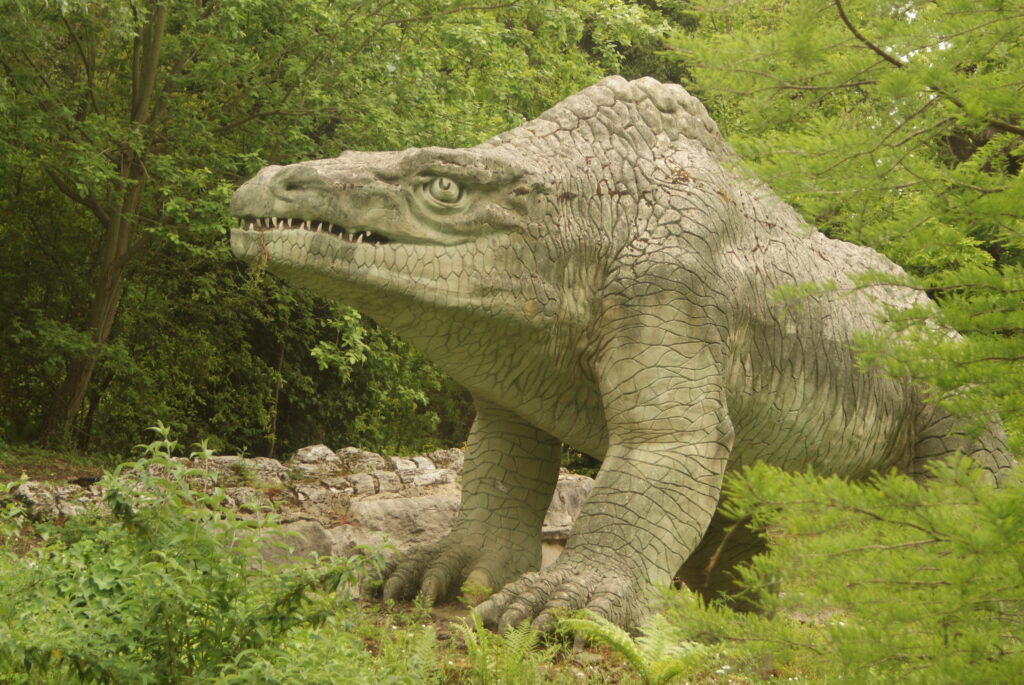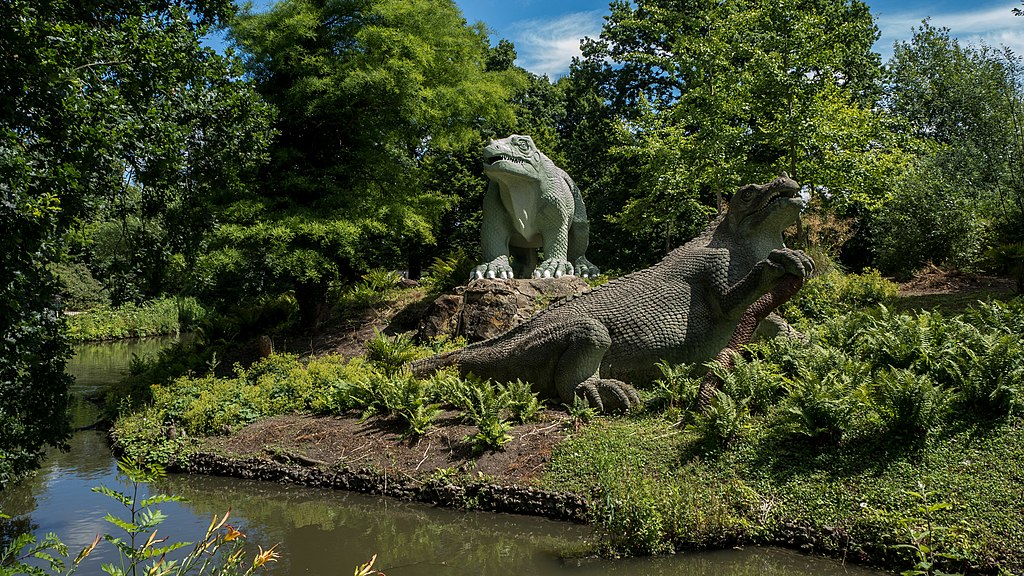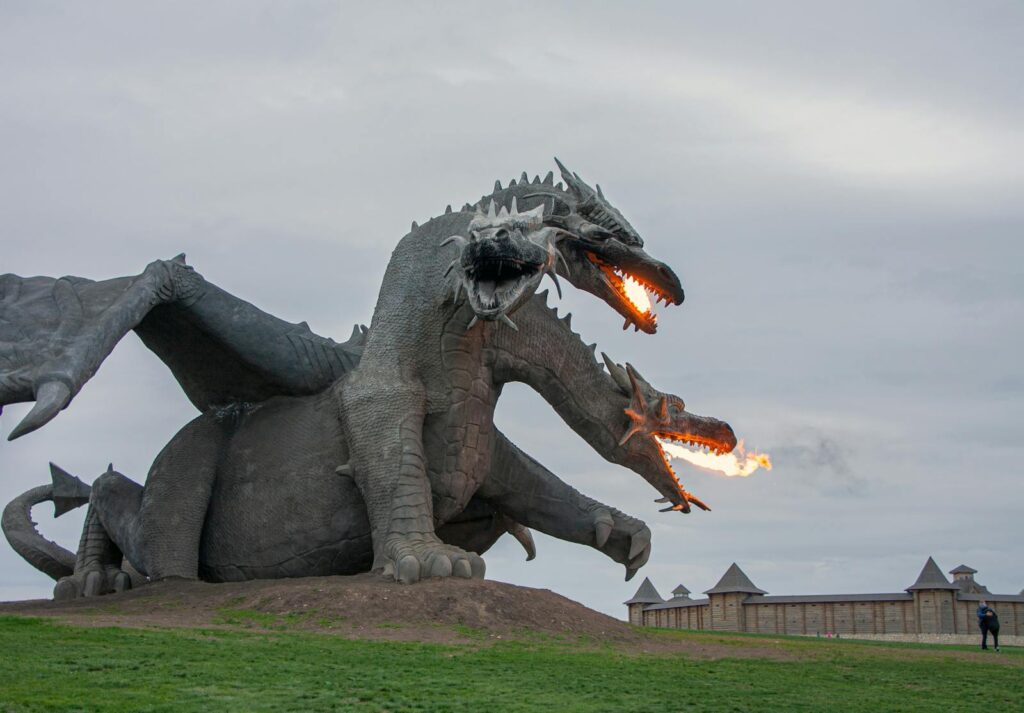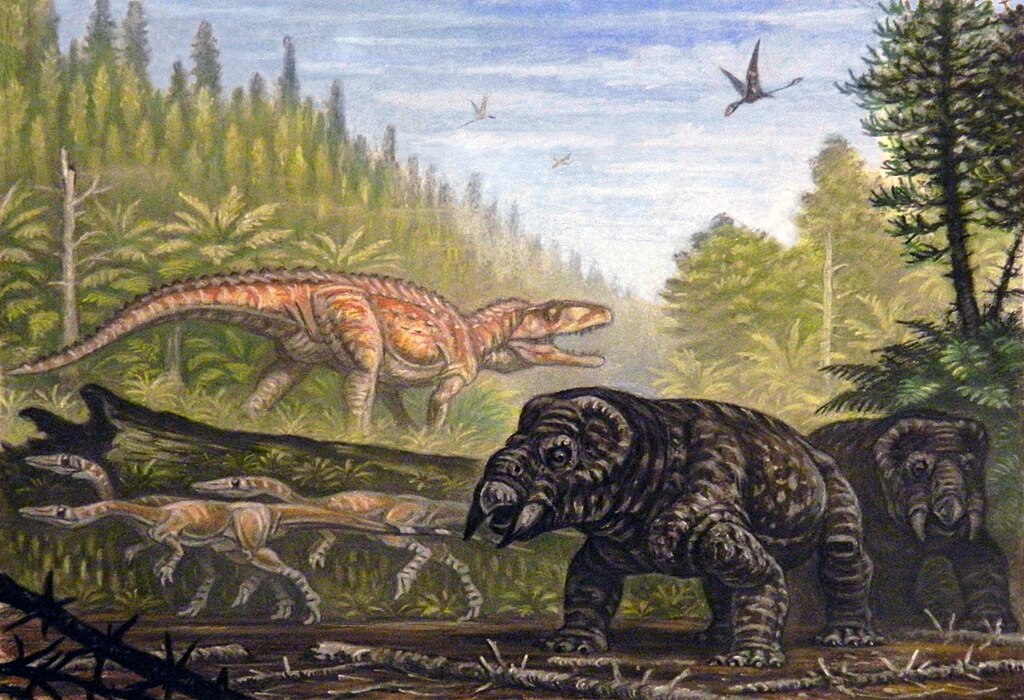The Crystal Palace Dinosaurs stand as remarkable monuments to Victorian science and imagination, representing the world’s first attempt to visualize extinct prehistoric creatures in three-dimensional form for public education and entertainment. Created in the 1850s, these life-sized sculptures predate even the coining of the word “dinosaur” and emerged during a time when paleontology was in its infancy. Located in London’s Crystal Palace Park, these sculptures constitute what can genuinely be considered the world’s first dinosaur theme park – a revolutionary concept that combined art, science, and public education decades before modern natural history museums became commonplace. Though scientifically outdated by today’s standards, these extraordinary sculptures remain historically significant as they capture a pivotal moment in the development of paleontology and demonstrate how our understanding of prehistoric life has evolved over the past century and a half.
The Origins of the Crystal Palace Park

The story of the Crystal Palace Dinosaurs begins with the Great Exhibition of 1851, a spectacular world’s fair held in London’s Hyde Park in a massive glass and iron structure dubbed the “Crystal Palace.” Following the exhibition’s success, the Crystal Palace was dismantled and relocated to Sydenham Hill in South London, where it became the centerpiece of a new recreational park. Joseph Paxton, the architect behind the original structure, envisioned a comprehensive educational and entertainment venue that would attract visitors from across Victorian society. The reconstructed Crystal Palace opened in 1854, surrounded by elaborate gardens, fountains, and themed courts representing various historical architectural styles. Among the park’s numerous attractions, perhaps none captured the public’s imagination quite like the prehistoric monsters created to populate its grounds – sculptures that would become known as the Crystal Palace Dinosaurs.
Richard Owen: The Scientific Mind Behind the Sculptures

The scientific direction for the Crystal Palace Dinosaurs came from Sir Richard Owen, a prominent naturalist and anatomist who coined the term “Dinosauria” in 1842. Owen was considered Britain’s leading paleontologist and served as superintendent of natural history at the British Museum. His influence on the Crystal Palace project was profound, as he provided scientific guidance to the sculptor Benjamin Waterhouse Hawkins regarding the appearance and anatomical details of these prehistoric creatures. Owen’s interpretations were revolutionary for his time, though many would later prove inaccurate as paleontological knowledge advanced. His vision for the dinosaurs positioned them as massive, quadrupedal reptiles rather than the more dynamic, often bipedal animals we now understand many of them to be. Despite later scientific revisions, Owen’s contributions represented the cutting edge of Victorian paleontology and helped establish dinosaurs in the public consciousness.
Benjamin Waterhouse Hawkins: The Artist Who Brought Prehistory to Life

The task of physically creating the Crystal Palace Dinosaurs fell to sculptor and natural history artist Benjamin Waterhouse Hawkins. Selected for his skill in depicting animals and his previous work with scientific illustrations, Hawkins faced an unprecedented artistic and technical challenge. Working from fragmentary fossil evidence and Owen’s scientific direction, he had to envision complete creatures that no human had ever seen. His workshop at Crystal Palace Park became a site of intensive labor and innovation, where he and his team constructed enormous iron frameworks, overlaid them with clay models, and finally cast them in concrete to create the durable outdoor sculptures we still see today. The scale of the project was immense—some models weighed up to 30 tons and required specialized construction techniques. Hawkins even famously hosted a dinner party inside his partially completed Iguanodon model on New Year’s Eve 1853, a publicity stunt that captured the Victorian public’s imagination and demonstrated the massive scale of his creations.
The Opening and Initial Public Reception

When the Crystal Palace Park officially opened to the public in 1854, the prehistoric creatures became an immediate sensation. Queen Victoria and Prince Albert attended the opening ceremonies, lending royal prestige to the endeavor. Visitors were astonished by the scale and vivid presentation of these previously unknown animals, which were presented as living beings in naturalistic settings complete with appropriate vegetation. The dinosaurs quickly became the park’s most popular attraction, drawing visitors from all social classes who were eager to encounter these mysterious creatures from Earth’s distant past. Guidebooks, postcards, and various souvenirs featuring the dinosaurs were produced to satisfy public demand. The sculptures sparked a widespread interest in paleontology among ordinary people who had never before considered prehistoric life. Contemporary accounts describe visitors’ amazement and sometimes terror at confronting these life-sized recreations of extinct beasts, marking the beginning of the cultural phenomenon we now recognize as “dinosaur mania.”
The Dinosaurs on Display: A Tour of the Prehistoric Landscape

The Crystal Palace Dinosaurs aren’t limited to dinosaurs in the strict scientific sense – they represent a broad collection of prehistoric life arranged chronologically around the park’s lakes. The display begins with Paleozoic marine reptiles and amphibians, including labyrinthodonts and ichthyosaurs, representing early evolutionary forms. Moving forward in time, visitors encounter massive mammal-like reptiles such as Dicynodon and the sail-backed Dimetrodon, creatures that predated true dinosaurs. The most famous sculptures, however, are the dinosaurs themselves – the massive Iguanodon with its misplaced thumb spike (which Owen incorrectly placed on its nose), the heavily-armored Hylaeosaurus, and the imposing Megalosaurus, which was portrayed as a quadrupedal beast rather than the bipedal predator we now know it to be. The displays conclude with prehistoric mammals like the Irish Elk and the massive ground sloth Megatherium, creating a comprehensive journey through evolutionary history as understood in the 1850s.
Scientific Accuracy: Victorian Knowledge vs. Modern Understanding

The scientific accuracy of the Crystal Palace Dinosaurs must be viewed within the historical context of mid-19th-century paleontology. When Hawkins and Owen created these sculptures, dinosaur paleontology was in its infancy – only a handful of dinosaur species had been named, often from highly fragmentary remains. Owen interpreted dinosaurs as massive, lizard-like reptiles, leading to representations that appear awkward and inaccurate to modern eyes. The Iguanodon, now known to be primarily bipedal with a thumb spike for defense, was portrayed as a heavy quadruped with the spike incorrectly placed on its nose like a rhinoceros horn. Similarly, Megalosaurus was depicted as a bulky quadruped rather than the agile bipedal predator revealed by later discoveries. Perhaps most noticeably absent is any hint of the evolutionary connection between dinosaurs and birds, a relationship completely unknown in Owen’s time. These inaccuracies, however, reflect the genuine state of scientific knowledge rather than carelessness, representing honest attempts to visualize the past with limited evidence.
The Crystal Palace Fire and Changing Fortunes

The fortunes of the Crystal Palace Park and its dinosaurs have fluctuated dramatically over the decades. The Crystal Palace structure itself tragically burned down in a spectacular fire in 1936, an event that devastated the park financially and symbolically. Despite this catastrophic loss, the dinosaur sculptures survived unscathed, preserved in their lakeside setting apart from the main building. The park endured further challenges during World War II when it served as a home for military vehicles, with some areas falling into disrepair. In the post-war period, the park changed hands several times, experiencing varying levels of maintenance and care. The dinosaurs themselves suffered from weathering, vandalism, and at times, institutional neglect as their scientific importance became overshadowed by more modern attractions. Yet despite these hardships, the dinosaur sculptures remained in place, silent witnesses to changing times and attitudes toward both recreational parks and scientific displays.
Conservation Challenges and Heritage Status

As concrete structures exposed to the elements for over 160 years, the Crystal Palace Dinosaurs face significant conservation challenges. The sculptures have suffered from extensive weathering, with internal iron frames rusting and expanding to crack the concrete shells. Vandalism has occasionally damaged features, while vegetation growth and water infiltration have compromised structural integrity in several models. Recognizing their cultural and historical significance, the dinosaurs were granted Grade I listed status in 2007, placing them among Britain’s most protected monuments. This designation acknowledged not only their artistic merit but also their importance to the history of science and public education. Despite this protection, funding for conservation has often been limited, leading to periodic public campaigns to save particular specimens. In 2020, one Megalosaurus statue partially collapsed into the lake, highlighting the ongoing fragility of these historic sculptures and prompting emergency restoration work to prevent further deterioration.
Modern Appreciation: From Scientific Curiosity to Cultural Icon

The perception of the Crystal Palace Dinosaurs has evolved significantly since their creation, transitioning from cutting-edge scientific exhibits to cherished cultural monuments. During the late 19th and early 20th centuries, as paleontological knowledge advanced rapidly, the sculptures increasingly became viewed as scientific curiosities rather than accurate representations. By the mid-20th century, they were widely regarded as charmingly antiquated relics of Victorian science. This perspective has shifted again in recent decades, with historians of science recognizing their immense value as three-dimensional documents of how scientific understanding evolves. Contemporary visitors appreciate them on multiple levels – as artistic achievements, as snapshots of Victorian scientific thought, and as nostalgic landmarks that have entertained generations of Londoners. Their distinctive silhouettes have been featured in literature, film, and art, cementing their status as cultural icons that transcend their original purpose as scientific models.
Educational Value in the 21st Century

Despite their scientific inaccuracies, the Crystal Palace Dinosaurs retain substantial educational value for modern visitors. Rather than simply presenting them as outdated curiosities, contemporary interpretative materials contextualize the sculptures within the history of scientific discovery, using them to illustrate how scientific understanding evolves through new evidence and revised theories. School groups regularly visit the park to learn not just about prehistoric creatures but about the process of scientific inquiry itself. The sculptures provide a tangible lesson in how science self-corrects over time, with each generation building upon and sometimes overturning previous knowledge. Educational programs often compare the Victorian reconstructions with modern understandings, highlighting specific advances in paleontological knowledge. This approach transforms potential scientific liabilities into valuable teaching tools, demonstrating that even “incorrect” scientific models contribute to the advancement of knowledge when subjected to continued research and revision.
The Friends of Crystal Palace Dinosaurs

The ongoing preservation and appreciation of the Crystal Palace Dinosaurs owes much to dedicated community efforts, particularly through the Friends of Crystal Palace Dinosaurs organization established in 2013. This charitable group combines the expertise of paleontologists, conservationists, historians, and local enthusiasts committed to protecting and promoting these unique heritage assets. The Friends conduct regular guided tours, organize educational events, and advocate for conservation funding from both public and private sources. Their activities have significantly raised the profile of the sculptures, helping to secure grants for restoration work and technical surveys of the monuments’ condition. The organization also maintains detailed documentation of the sculptures’ history and current state, creating a valuable resource for researchers and conservators. Through social media and public engagement, the Friends have successfully cultivated a global community of supporters who recognize the dinosaurs’ significance to both local heritage and the international history of science communication.
Similar Victorian Dinosaur Displays Around the World

While the Crystal Palace Dinosaurs represent the first and most complete prehistoric theme park of the Victorian era, they inspired similar endeavors elsewhere, creating a tradition of public paleontological displays. In the United States, Hawkins himself was commissioned to create dinosaur models for Central Park in New York City, though this project was infamously sabotaged by political interference before completion. Later Victorian-era dinosaur models can be found in other European parks and gardens, including the Natural History Museum in Paris and various botanical gardens that incorporated paleontological themes. These international cousins to the Crystal Palace Dinosaurs reflect the widespread Victorian fascination with prehistoric life and the desire to make paleontological discoveries accessible to the public. Though few survived as completely as the London examples, together these displays represent an important chapter in the popularization of paleontology, bridging the gap between academic science and public education during a formative period in both disciplines.
Legacy and Influence on Modern Dinosaur Attractions

The Crystal Palace Dinosaurs established a template for public engagement with prehistoric life that continues to influence modern dinosaur attractions around the world. From the dinosaur halls of natural history museums to sophisticated theme park attractions like Jurassic Park, contemporary dinosaur displays inherit the fundamental concept pioneered at Crystal Palace: bringing extinct creatures to life through three-dimensional, life-sized reconstructions in naturalistic settings. The Victorian sculptures demonstrated the immense public appetite for encountering prehistoric life, establishing dinosaurs as perennial favorites for educational entertainment. Modern paleontological displays have certainly evolved technologically, incorporating animatronics, digital projections, and interactive elements unimaginable to Victorian creators – yet they share the same core purpose of making the distant past tangible and accessible. Even as scientific understanding and presentation techniques have advanced dramatically, the emotional impact of standing beside a life-sized dinosaur remains powerful, connecting modern visitors to their Victorian predecessors through a shared sense of wonder at Earth’s extraordinary prehistoric inhabitants.
Conclusion

The Crystal Palace Dinosaurs represent a fascinating intersection of art, science, and public education that continues to captivate visitors more than 160 years after their creation. Though scientifically outdated, these remarkable sculptures offer an irreplaceable window into the development of paleontology and the Victorian imagination. As the world’s first dinosaur theme park, they pioneered the concept of bringing prehistoric creatures to life for public entertainment and education, establishing a tradition that continues in museums and attractions worldwide. Their ongoing preservation ensures that future generations can appreciate both the history of scientific discovery and the creative vision that brought these creatures into the public consciousness. The Crystal Palace Dinosaurs stand not merely as curious relics but as monuments to humanity’s enduring fascination with the prehistoric world and our continuing efforts to understand and visualize Earth’s distant past.



